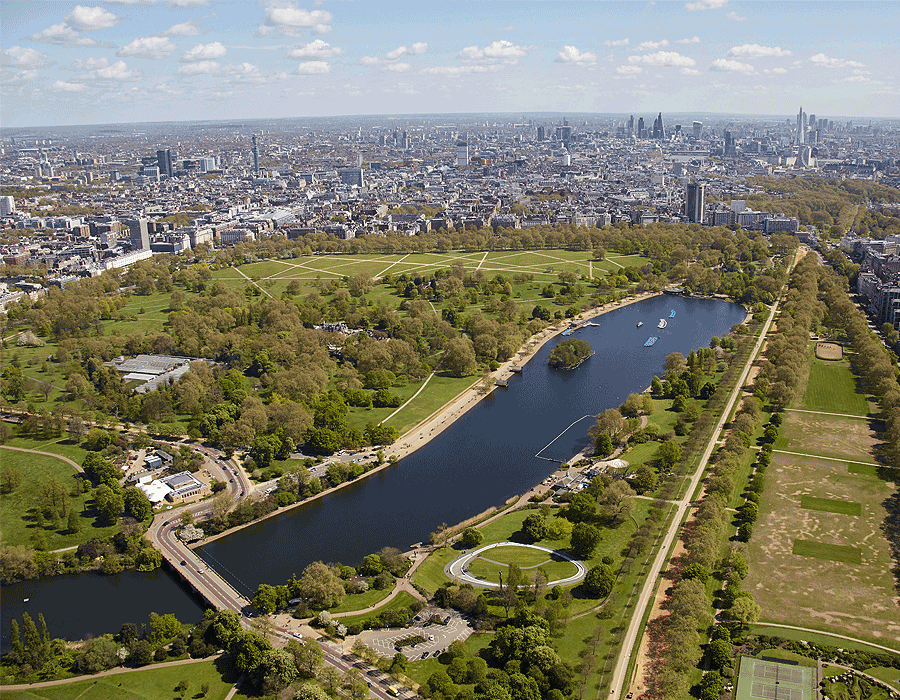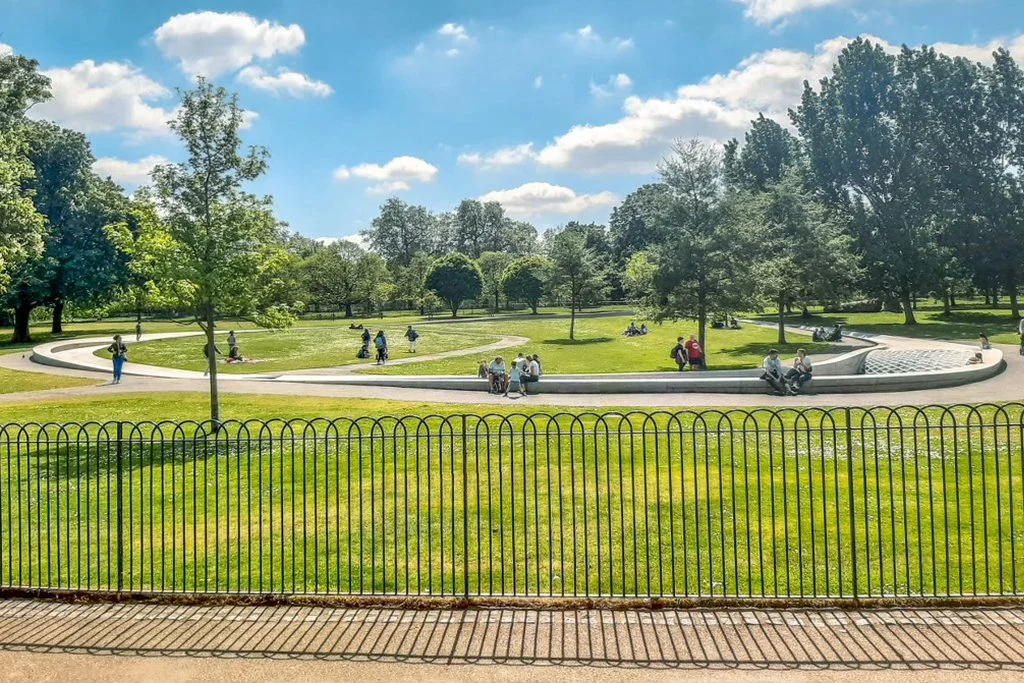Hyde Park is not only one of the largest and most beloved green spaces in London but also one of the most historically and culturally significant parks in the world. Situated in the very heart of the city, it has been a royal hunting ground, a stage for political protest, a venue for grand exhibitions, and a sanctuary for generations of Londoners and visitors. Covering 350 acres, Hyde Park forms part of a continuous chain of green spaces that includes Kensington Gardens, Green Park, and St James’s Park, together shaping the lungs of central London.

Origins and Early History
The origins of Hyde Park stretch back to the early 16th century. In 1536, during the reign of Henry VIII, the land was seized from Westminster Abbey and transformed into a royal hunting ground. Deer were kept on the land, and for over a century, it remained closed to the general public.
It was not until the reign of James I in the early 17th century that limited access was granted. By the time of Charles I, in 1637, Hyde Park was opened to the general public, a decision that marked the beginning of its long-standing reputation as a space for recreation, gatherings, and social life.
During the 18th and 19th centuries, Hyde Park evolved further, shaped by the needs of London’s growing population and by grand architectural interventions. Queen Caroline, consort of George II, played a major role in the 1730s by initiating a series of improvements, including the creation of the Serpentine, a large artificial lake that remains the park’s centerpiece today.
The Serpentine and the Long Water
The Serpentine is perhaps the most famous feature of Hyde Park. This curving, 40-acre body of water was one of the earliest artificial lakes in England designed in a naturalistic style. Unlike the formal, geometric lakes typical of earlier landscaping, the Serpentine’s flowing lines reflected the English landscape garden movement that would later become globally influential.
The Serpentine is divided into two sections: the eastern section retains the name Serpentine, while the western portion is known as the Long Water and technically belongs to Kensington Gardens. Together, they provide a habitat for swans, ducks, geese, and countless other bird species, making them a haven for nature in the middle of the metropolis.
Today, the Serpentine is a hub of activity. In the summer, visitors enjoy boating on its waters, and the Serpentine Lido offers swimming opportunities for those brave enough to take a dip. The Serpentine Bridge, built in 1826, elegantly spans the lake, providing one of the most iconic views in the park.
A Place for Recreation
Hyde Park has long been a place for leisure and recreation. In the 17th century, it became fashionable for London’s elite to parade along Rotten Row, a broad track created for horse-riding. Rotten Row, lit by 300 oil lamps, was the first artificially lit highway in Britain, and it remains a popular bridleway today, alongside serving as a walking and jogging path.
As London grew, Hyde Park became a vital breathing space for its citizens. Today, the park offers a wide range of recreational facilities, from open lawns for picnicking and sports to playgrounds for children. Joggers, cyclists, rollerbladers, and dog walkers share its paths, while the wide expanses of grass accommodate football, frisbee, and impromptu games.
For those seeking a quieter experience, the park also offers secluded spots shaded by mature trees, flower gardens, and meadows that burst into colour in spring and summer. It is this balance between open activity and quiet retreat that makes Hyde Park so universally loved.
A Stage for Protest and Free Speech
One of Hyde Park’s most significant roles has been as a stage for political protest and free speech. In 1855, when the government banned protests against Sunday trading laws, demonstrators defied the restrictions by gathering in Hyde Park. This set the precedent for the park as a site of public expression.
In 1866, mass demonstrations by the Reform League for voting rights took place in Hyde Park, drawing huge crowds. The authorities attempted to suppress the gatherings, but the scale of the protests reinforced the park’s role as a public forum.
This tradition continues at Speaker’s Corner, located in the northeast corner of the park near Marble Arch. Established in 1872, Speaker’s Corner has become synonymous with free expression. Here, anyone can stand on a platform—often a simple soapbox—and address the crowd on almost any subject. Over the years, it has hosted figures ranging from Karl Marx and George Orwell to ordinary Londoners seeking an audience. Even today, Speaker’s Corner remains a lively symbol of democracy and freedom of speech.
Cultural Events and Concerts
Beyond protest and politics, Hyde Park has also been a stage for culture, entertainment, and celebration. In 1851, the park was the site of the Great Exhibition, a landmark event showcasing industrial achievements from around the world. The exhibition was housed in the Crystal Palace, a vast glass structure designed by Joseph Paxton. Though the palace was later relocated to Sydenham, the memory of the Great Exhibition underscores Hyde Park’s role in the history of innovation and spectacle.
In the 20th and 21st centuries, Hyde Park has hosted some of the most memorable concerts and public events in London. Legendary performances include the Rolling Stones’ free concert in 1969, attended by an estimated 250,000 people, and the Live 8 concert in 2005, part of a global campaign to end poverty. More recently, the park has become the venue for the British Summer Time Hyde Park festival, drawing major international artists and tens of thousands of music fans each year.
The park has also been a focal point for national celebrations, including royal jubilees and public gatherings to mark significant occasions such as the London 2012 Olympic Games.
Monuments and Memorials
Scattered throughout Hyde Park are numerous statues, fountains, and memorials that add layers of history and meaning to the landscape.
- The Diana, Princess of Wales Memorial Fountain is among the most visited features. Opened in 2004, the fountain is a striking modern design made from Cornish granite, with water flowing in two directions before meeting in a calm pool. It was designed to reflect Diana’s openness, inclusiveness, and love of children.
- The Holocaust Memorial, created in 1983, was the first such memorial in Britain, offering a place of reflection and remembrance.
- The Cavalry Memorial, dedicated in 1924, commemorates members of the cavalry regiments who died in the First World War.
- The Joy of Life Fountain and the Achilles statue (unveiled in 1822 to honour the Duke of Wellington) are other significant landmarks.
Each monument reflects an aspect of London’s history and collective memory, making Hyde Park not just a recreational space but also a site of remembrance and meaning.
Wildlife and Nature
Hyde Park is a haven for wildlife, despite its urban setting. The Serpentine and Long Water attract numerous bird species, including swans, coots, herons, and great crested grebes. The park’s trees and meadows provide habitats for bats, squirrels, insects, and other small animals.
In recent decades, efforts have been made to increase biodiversity within the park. Areas of meadow have been restored, wildflowers planted, and deadwood left in certain areas to encourage insect populations. These initiatives ensure that Hyde Park remains not only a cultural and recreational treasure but also an ecological one.
The Park Today
Today, Hyde Park attracts millions of visitors each year. Its central location, cultural history, and sheer size make it one of the most popular destinations in London. For tourists, it is a must-see attraction; for Londoners, it is a cherished green space where they can exercise, relax, or simply escape the urban bustle.
The park is managed by The Royal Parks charity, which oversees its maintenance, conservation, and public programming. The balance they strike between preserving the park’s historic features and ensuring its relevance to modern needs is a testament to its enduring importance.
Conclusion
Hyde Park is more than a park; it is a microcosm of London itself. It embodies the city’s history, from its royal origins to its role as a stage for protest and celebration. It reflects London’s diversity, offering space for solitude, recreation, culture, and free speech. Its monuments remind us of the past, while its concerts and events point to a vibrant present. Above all, it remains a living, breathing heart of the capital, cherished by all who enter its gates.
To walk through Hyde Park is to experience centuries of history layered upon natural beauty. Whether one comes for the tranquillity of the Serpentine, the energy of Speaker’s Corner, or the excitement of a summer concert, Hyde Park offers something for everyone. In the words of many Londoners, it is not just a park—it is a way of life, a space where the spirit of the city is most alive.

